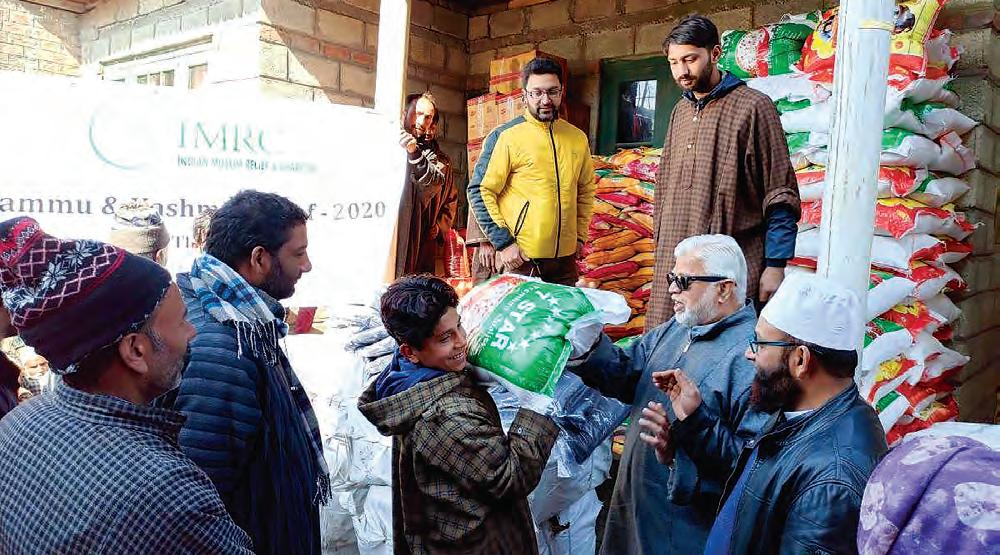
9 minute read
The Logic Behind the Kashmir
The Logic Behind the Kashmir Lockdown Another step toward Hindutva’s longed-for Hindu-only India
BY ANUBHAV SINGH
Advertisement
K. B. Hegdewar V. D. Savarkar M. S. Golwalkar Narendra Modi Amit Shah
The erasure of Kashmir’s statehood and the unprecedented information lockdown effected on Aug. 5, 2019 [which continues as this magazine goes to print], the passage of the
Citizenship (Amendment) Act, 2019 (CAA), the denial of citizenship rights to almost 2 million people in Assam based on the National Registry of Citizens (NRC) and the Indian Supreme Court’s Nov. 9, 2019 Babri Masjid verdict are only few of an alarming sequence of events that signify democracy’s dimming future in Prime Minister Narendra Modi’s India, currently ruled by the Bharatiya Janata Party (BJP).
More than 50 primarily Muslim individuals died in the March 2020 riots in northeastern New Delhi sparked by BJP leaders Kapil Mishra, Deputy Finance Minister Anurag Thakur, BJP parliamentary member Parvesh Verma and State Assembly member Abhay Verma’s incendiary speeches.
The riots are another link in the a chain of events signalling India’s relentless descent into an ethnic state where, theoretically, Muslim Indians continue to enjoy constitutional and legal rights similar to the Hindu majority, but in a state whose structures are ethnically dominated by majorly upper caste (savarna) Hindus with a very specific Hindu worldview.
To many outside observers, the erosion of India’s democratic and constitutional values seems surprising. Due to its long-standing status as “the world’s largest democracy,” the country has been considered a beacon of secular and democratic values in a region tormented by communal and sectarian violence. However, almost 70 years after independence, Muslim Indians, having been assured of a “secular” state by its founders, now find themselves fighting a battle for survival in which no political party, whether “secular” or “communal,” has sought to draw them into the national political, social and economic mainstream.
Muslims and Dalits (“untouchables”) still exist at the margins of India's democratic institutions, and upper caste Hindus dominate the administration, police and military cadres. After the Hindu vote was consolidated in 2014, Muslims began vanishing from the Lok Sabha (the Upper House) and state assemblies. While the Indian state’s character has been majoritarian for almost its entire existence, the current regime is now facing a crisis of legitimacy as it actively seeks to socially, politically and economically marginalize its most disempowered citizens.
To understand why this is the case, we must understand the driving ideology and the organization behind them — Hindutva and the Rashtriya Swayam Sevak Sangh (RSS), the BJP’s ideological parents.
K. B. Hegdewar founded the RSS in 1925 to “organize the entire Hindu society from Kanyakumari [southernmost tip] to the Himalayas [northernmost tip].” He developed the shakha (local branches) model, where uniformed volunteers would be given physical and ideological training. The RSS’s immediate inspiration were Mussolini’s Brown Shirts, and its ideology came from V. D. Savarkar, a Maharashtrian Brahmin who devised the idea of Hindutva (pure Hinduness). Savarkar’s seminal “Hindutva: Who’s a Hindu” [originally “Essentials of Hindutva,” 1923], identified Muslims, not the British colonial rulers, as the Hindus’ main enemy. He viewed Muslims as a close-knit community having a pan-Islamic, instead of a nationalist vision, and thus a danger to what he conceived as the real nation — a Hindu Rashtra.
This particular concept was derived from the European Westphalian nation-state system and defined mainly along ethnic lines. For Savarkar, Hinduism was just one attribute of “Hinduness,” where “Hindu” was essentially a national identity comprising territorial, racial, geographical and cultural attributes. According to him, Hindus were the descendants of the Aryans who had settled between the Himalayas and the Indian Ocean at the dawn of history.
This was his Hindustan – an all-Hindu land defined by a common culture, rituals, social rules, mores and language. Viewing Sanskrit as “a language par excellence” and a reference point for all Indian languages, he demanded that either it or Hindi, its close cousin, be proclaimed the “national language.”
Hindustan’s minorities, namely, Muslims and Christians, were the threatening “Others,” for Hindustan was their Pritubhumi
(Fatherland) but not their Punyabhumi (Holy Land). They were parts of the Hindu race who had been forcibly converted into non-Hindus and could only be reintegrated into the Hindu fold by paying allegiance to Hindu culture and recognizing Hindustan as their Holy Land. These Hindutva tenets were made more rigid by M. S. Golwalkar, who went on to label all non-Hindus and those who didn’t subscribe to the “social laws of the Hindu religion and culture” as Dalits (mlecchas: an ancient Sanskrit term for foreigners or barbarians [i.e., non-Aryans]). Such people have always existed on the caste system’s fringes.
Taking inspiration from Hitler, Golwalkar further emphasized the primacy of race as the driving factor behind nationhood and labelled Muslims “foreign bodies” lodged in Hindu society. He proclaimed, “To keep up the purity of the Race and its culture, Germany shocked the world by her purging the country of the semitic Races — the Jews. Race pride at its highest has been manifested here. Germany has also shown how well-nigh impossible it is for Races and cultures, having differences going to the root, to be assimilated into one united whole, a good lesson for use in Hindusthan to learn and profit by” (“Our Nationhood Defined”, Bharat Publications, Nagpur India, 1939, p.35).
The Hindu nation’s other enemies, as envisioned by Golwalkar, were Christians and communists. Dr. Gyanendra Pandey (Arts and Sciences Distinguished professor; director, Interdisciplinary Workshop on Colonial and Postcolonial Studies at Emory University) characterizes the idea of a Hindu nation as “upper caste racism” (“A History of Prejudice: Race, Caste, and Difference in India and the United States,” 2015).
Modi and current Home Minister Amit Shah, both lifelong RSS members, belong to this school of thought.
The process of constructing this upper caste hegemony in the name of the envisaged Hindu Rashtra is being achieved through legalism and vigilantism by active state participation. The country has become a de jure Hindu Rashtra via legal and constitutional means to imprint the state’s majoritarian character on the Muslim mind, despite being officially secular in nature. Thus, Kashmir’s statehood has been erased on the pretext of securing India’s borders from external enemies (Pakistan) while cracking down on Kashmiri Muslims, who are accused of harboring pro-Pakistan secessionist tendencies.
Savarkar envisioned such a territorial integration of the Hindu Rashtra. The RSS has consistently opposed the autonomy granted to Jammu and Kashmir by article 370 of the Indian constitution as a condition of its “accession” to India, when it invaded and occupied the princely state in 1947.
The passage of the CAA, which together with the planned NRC threatens to deprive Indian Muslims of their citizenship, is just an extension of Hindutva’s racial attribute of citizenship, which does not recognize Muslims, Christians and Dalits as citizens.
Despite recognizing that the Dec. 6, 1992 demolition of the 660-year old Babri Masjid (by the RSS mobilized Hindu militants) as an illegal act, the Supreme Court nevertheless awarded the land to a specifically government-created trust to build the Ram Mandir in its place.
The second means to relegate these two minorities to the fringes of India’s society has been the activation of Sangh Parivar,non-state militias. Part of the RSS “family,” these militias violently enforce such social “norms” as preventing marriages between Hindu women and Muslim men (dubbed “the Love Jihad”), inter-caste marriages between Dalit men and upper caste Hindu women, segregation in urban spaces to stop “Muslim occupation” of the land (dubbed “the Land Jihad”) and preventing the slaughter of cows (cow protection), a movement that has led to the lynching of Muslims and Dalits across the country.
The last element is rather ironic, considering that Binay Singh’s March 15, 2019, article in The Times of India (https://timesofindia. indiatimes.com) quotes Seer Swami Swaroopanand Saraswati as stating: “This is the same Modi, who as a chief minister of Gujarat used to say painfully that his heart is burning to see cow slaughter in the country, but after becoming Prime Minister he made the India the biggest exporter of beef.”
These militias’ violent operations often enjoy state patronage and protection, for the police have remained rather unconcerned when mob attack such people.
Relief Efforts in Kashmir and New Delhi
IMRC executive director Manzoor Ghori (second right) supervised relief operations in Indian-occupied Kashmir

MUSLIMS IN INDIA AND [INDIANOCCUPIED] Kashmir face an existential crisis under the Narendra Modi’s Hindutva supremacist regime. The anti-Muslim pogrom in New Delhi afflicted an estimated $34.65 billion loss to businesses and rendered hundreds of families who are now living in makeshift camps, homeless.
To help ease to their sufferings, the U.S. based Indian Muslim Relief and Charities (IMRC) sent its Emergency Response Teams to [Indian-occupied] Kashmir and New Delhi to assess the situation and subsequently provided immediate relief.
Since November 2019, IMRC has provided food packages and pherans (traditional Kashmiri jackets worn in winter) to nearly 3,000 families in Kashmir. Other relief projects suggested by local Kashmiri volunteers are underway.
In New Delhi, IMRC volunteers have distributed relief packages to more than 1,000 riot-affected families. The packages include rice, flour, a variety of lentils, spices, cooking oil, baby milk formula, salt, oats, sugar, tea, cookies, sanitary and personal hygiene supplies, and flip-flops.
IMRC is currently conducting a survey in the affected areas to rehabilitate the victimized families. ih
The construction of the Hindu Rashtra — institutionalizing upper caste hegemony in the state structures and enforcing Brahmanical Hinduism’s social “norms” is indeed underway in India as the interests of the BJP government and its ideological parent, the RSS, converge and India moves rapidly away from its constitution’s secular and democratic ideals.
Over the years, the RSS has grown into a Janus-faced organization with enough power to enforce its version of the law either through grassroots organization and social work or through violent means. Since 2014, the ostensibly democratic and secular Indian state has facilitated this transformation so that one wonders if the country still deserves its title as “the world’s largest democracy.”
Noting that it was Obama who had dignified ties with Modi, but that Trump has been taking them to colossal heights, Mumbai, India-based journalist Akanksha Singh, who covers politics and social justice and has written for the BBC and other international publications, aptly warned, “We in India are still in the early phases of this terrifying regime, but if the world doesn’t stand up and take notice soon, it will only get worse. India is very concerned about her image globally right now — it’s the reason a wall was built to hide slums before Trump’s visit.”
She implored: “It’s important for the president of the world’s top superpower, as well as the candidates seeking to replace him, to condemn the ongoing hate crimes against Muslims as they unfold within the borders of an important ally and trading partner as it gains attention on the world stage” (“Democracy is dying in India, and Trump shouldn’t be on Modi’s side”, CNN, March 22, 2020). Although it is rather late in the day, it’s time for those countries of the world that still value democracy to wake up and seek to end this new violent apartheid state being created in the name of democracy. ih











